 How a registered nurse became a breakout police procedural novelist—and why she adores historical romance
How a registered nurse became a breakout police procedural novelist—and why she adores historical romance
Amy Pease’s immensely readable debut is one you’ll have a hard time putting down.
From Northwoods’ eerie opening scene, we know we’re in for a wild ride. Deputy Eli North, an alcoholic veteran of the War in Afghanistan with PTSD and a checkered past, stumbles upon the body of a teenager in a lake in northern Wisconsin. Can Eli and his mother—the sheriff of their small resort town—solve the mystery of who killed the boy, and why?
Pease introduces us to a motley crew as her engaging and fast-paced story unwinds. Some of her characters are full-time residents of bucolic Shaky Lake, while others are moneyed summer vacationers. Toss in a few pharmaceutical salespeople, an FBI agent, and a missing girl, and we begin questioning everyone’s motives.
Pease writes with a warmth and familiarity that make her often weighty subject matter digestible, even if readers aren’t acquainted with the intricacies of America’s opioid epidemic. Indeed, considering her long and successful career as a registered nurse, Pease brings a singular perspective to her storytelling.
Perhaps, then, the question isn’t Who killed the teenage boy in Shaky Lake? but rather How did an HIV specialist from Madison, Wisconsin become a nationally-known breakout writer?
***
Amy, tell me about your career as a nurse and how it has informed and inspired your writing of Northwoods.
Literature and creative writing have always been my first loves, but I decided early on that I needed to go the practical route first, career-wise. My dad worked in healthcare, and I knew I wanted to do something that involved helping people, which led me to nursing. You don’t get much more practical and people-oriented than that.
I’ve always gravitated towards nursing jobs involving marginalized and vulnerable groups, and that’s had a huge impact on my writing. Instead of only experiencing the white, upper-middle-class bubble I was born into, where everybody has a roof over their heads and a good job and a healthy family, I’ve been afforded a glimpse of lives that look very different from mine. It’s easy to fall back on stereotypes and biases when you’re writing fiction without real-life insight. Mental health and addiction, especially, are widely misunderstood and stigmatized, even though they affect a large number of people. My experience as a nurse has allowed me to push back against those stereotypes, which, frankly, don’t make for very interesting fiction anyway.
In addition to your demanding career, you have a husband and two children. How have you balanced your writing life with these other big responsibilities?
I wrote Northwoods over the course of about four years, very part time, by taking a few hours here and there on weekends to go to a coffee shop and work. (My husband referred to it as my “hobby”.) It’s a very inefficient way to write.
Transitioning from my “real life” brain to my “fiction-writing” brain is tough, so writing for an hour here and there doesn’t work that well. Now that I have deals for the next two books in the Northwoods series, I have a pretty tight deadline. I’m still figuring out how to juggle things, but having that deadline definitely motivates me to make the most of any spare time I have.
For the book I’m currently working on (book two in the Northwoods series), I spent the past year developing a very detailed synopsis of the plot and am now going chapter by chapter and actually writing the story. I aim for about 3000 words per chapter, so I use that as a measuring stick for when I’m “done” with a chapter.
Of course, once all the chapters are written, I’ll go back multiple times to improve things and make necessary changes. The early drafts are always terrible.
Have you always wanted to write?
I’ve imagined myself as a writer since I was in elementary school. Did I ever really write anything up until about five years ago? Not really. But I would say I’ve been a lifelong student of the craft. I’ve read every book, watched every YouTube video, listened to every podcast, attended writing workshops, and paid close attention to what makes a good book good and a bad book bad. It’s a creative/artistic process that’s always fascinated me.
Northwoods, specifically, came to me in a flash of inspiration one day. The more I thought about the concept and the characters, the more I knew that it was a story worth telling.
Let’s talk about the hybrid genre of mystery/thriller/police procedural. Did you always know that Northwoods was going to fall within this distinctive category?
The idea for Northwoods came from a very vivid image I had of a melancholy man—Eli North—floating in a lake at night, when music starts playing across the water. I wrote that scene out and let that momentum take me through two more chapters, and at the end of those chapters, a dead body was found. I had never intended on writing crime fiction, but it was the story that was inside of me and demanded to be told.
What do you like to read most? How have books shaped you?
Although I love a good swashbuckler, my favorite genre to read for fun is historical romance.
The romance genre has some truly exceptional writers, and a lot of my favorite historical romances include a crime/mystery element. Great examples are the Spymaster series by Joanna Bourne and the Mistress of the Art of Death Series by Arianna Franklin.
I enjoy romance because it’s very character driven. If I don’t care about the characters, it’s difficult for me to care about the plot. I don’t reach for genre mysteries if they’re only about solving the puzzle; I want to know about the people involved. I also love legal thrillers, like those from John Grisham or Michael Connolly.
My favorite crime fiction is the Cormoran Strike series by Robert Galbraith. They are extremely character-driven, and I keep coming back to them—all seven 1000+ page books—because I want to know what Strike and Robin are up to.
I also get crime fiction in the form of television, like Broadchurch, Ozark, and The Wire—shows where you get to know the characters.
***
The Spymaster’s Lady by Joanna Bourne
There is some truly exceptional writing in The Spymaster’s Lady. I aspire to write as well as Johanna Bourne! This is literature that happens to have some crime and sex, as well as some really interesting insights into the Reign of Terror era in post-revolutionary France. What could be better?
Mistress of the Art of Death by Arianna Franklin
Adelia, a female doctor from Cambridge, England who specializes in forensic autopsies is called on by King Henry II to catch a serial killer. Arianna Franklin’s book is set in the Middle Ages, and the characters, story, and setting are all incredible. It’s so unique and so well-written.
The Rogue Not Taken by Sarah MacLean
This road-trip-with-only-one-bed Regency romance manages to be funny, engaging, and sexy. Sarah MacLean could give a masterclass on how to create characters you love (or love to hate) and then bring them together in complex relationships that are more than the sum of the parts. Her books are an example of the genre done right.
- Northwoods Author Amy Pease Interview and Book Recommendations - April 29, 2024
- Still True author Maggie Ginsberg:Interview and Book Recommendations - September 14, 2022
- When wood and words come together:A children’s picture book is born - June 30, 2022

Leave A Comment